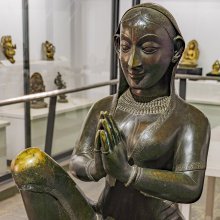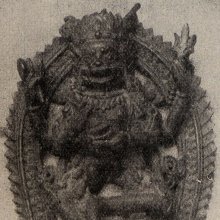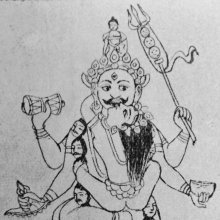Sundari, Sundarī, Sumdari: 31 definitions
Introduction:
Sundari means something in Buddhism, Pali, Hinduism, Sanskrit, Jainism, Prakrit, Marathi, biology. If you want to know the exact meaning, history, etymology or English translation of this term then check out the descriptions on this page. Add your comment or reference to a book if you want to contribute to this summary article.
Images (photo gallery)
(+2 more images available)
In Hinduism
Natyashastra (theatrics and dramaturgy)
Source: Wisdom Library: Nāṭya-śāstraSundarī (सुन्दरी) is the name of an Apsara created for the sake of a type of dramatic perfomance. Acording to the Nāṭyaśāstra 1.46-51, after Brahmā asked Bharata for materials necessary for the Graceful Style (kaiśikī: a type of performance, or prayoga), Bharata answered “This Style cannot be practised properly by men except with the help of women”. Therefore, Brahmā created with his mind several apsaras (celestial nymphs), such as Sundarī, who were skillful in embellishing the drama.
Source: archive.org: The mirror of gesture (abhinaya-darpana)One of the four Necks: Sundari: moving to and fro horizontally (tiryak-pracalita). Usage: the beginning of affection, making trial, saying “Well done!”, recollection, badinage, sympathetic pleasure.

Natyashastra (नाट्यशास्त्र, nāṭyaśāstra) refers to both the ancient Indian tradition (shastra) of performing arts, (natya—theatrics, drama, dance, music), as well as the name of a Sanskrit work dealing with these subjects. It also teaches the rules for composing Dramatic plays (nataka), construction and performance of Theater, and Poetic works (kavya).
Shaivism (Shaiva philosophy)
Source: Wisdom Library: Ṣaṭsāhasra-saṃhitāSundarī (सुन्दरी):—One of the twelve guṇas associated with Kāma, the second seat of the Svādhiṣṭhāna-chakra. According to tantric sources such as the Śrīmatottara-tantra and the Gorakṣasaṃhitā (Kādiprakaraṇa), these twelve guṇas are represented as female deities. According to the Ṣaṭsāhasrasaṃhitā however, they are explained as particular syllables. They (e.g. Sundarī) only seem to play an minor role with regard to the interpretation of the Devīcakra (first of five chakras, as taught in the Kubjikāmata-tantra).
Source: Brill: Śaivism and the Tantric TraditionsSundarī (सुन्दरी) refers to “(those who are) able bodied” [?], according to the Jayadrathayāmala, Ṣaṭka 1 verse 13.3–18::—Accordingly, “[...] [And], O Goddess, [the Śivadharmadīkṣā] has two forms: in Śaiva scriptures the division of initiation is called that without the seed and that with the seed. [...] The sabījā is the opposite to this and is performed, O beautiful one, for those who are learned, endure extremes and are able bodied (sundarī). By those the rituals towards the Guru, the God and the fire have to be performed with extreme devotion, since the desired fruit will not come about for them who don’t do [these rites]. [...]”.

Shaiva (शैव, śaiva) or Shaivism (śaivism) represents a tradition of Hinduism worshiping Shiva as the supreme being. Closely related to Shaktism, Shaiva literature includes a range of scriptures, including Tantras, while the root of this tradition may be traced back to the ancient Vedas.
Shaktism (Shakta philosophy)
Source: Wisdom Library: ŚāktismSundarī (सुन्दरी, “Beautiful”):—One of the female offspring from Mahāsarasvatī (sattva-form of Mahādevī). Mahāsarasvatī is one of the three primary forms of Devī, the other two being Mahālakṣmī and Mahākālī. Not to be confused with Sarasvatī, she is a more powerful cosmic aspect (vyaṣṭi) of Devi and represents the guṇa (universal energy) named sattva. Also see the Devī Māhātmya, a Sanskrit work from the 5th century, incorporated into the Mārkaṇḍeya-Purāṇa.
Source: Kamakoti Mandali: The Yoginis of Narasimha VyuhaSundarī (सुन्दरी) is the name of a Mātṛkā-Śakti created by Mahārudra in order to control the plague of demons created by Andhakāsura.—Accordingly, Andhaka-Asura tried to kidnap Umā (Devī Pārvatī), and was fiercely attacked by Mahārudra who shot arrows at him from his mahāpināka. when the arrows pierced the body of Andhakāsura, drops of blood fell to earth and from those drops, thousands of Andhakas arose. To control this plague of demons, Mahārudra created Mātṛkā-Śaktis [viz., Sundarī] and ordered them to drink the blood of the demons and drain them dry.
Source: Kamakoti Mandali: Nrisimha matrika-mandalaSundarī (सुन्दरी) refers to one of the various Mātṛkā-Śaktis created by Rudra in order to destroy the clones that spawned from Andhaka’s body.—Accordingly, [...] Andhakāsura attempted to abduct Girājanandinī (Pārvatī) and thus ensued a fierce battle between Andhakāsura and the great Rudra, the Lord of Umā. Like raktabīja, every drop of blood that fell from the body of Andhaka created another Asura like him and in no time, the entire world was filled with Andhakas. To destroy the growing number of Andhakas, Rudra created innumerable Mātṛkā-Śaktis [viz., Sundarī]. These Śaktis of immense power at once began to drink every drop of blood that flowed from the body of Andhaka, but they could still not effectively contain the emergence of more and more demons.

Shakta (शाक्त, śākta) or Shaktism (śāktism) represents a tradition of Hinduism where the Goddess (Devi) is revered and worshipped. Shakta literature includes a range of scriptures, including various Agamas and Tantras, although its roots may be traced back to the Vedas.
Purana and Itihasa (epic history)
Source: Wisdom Library: The Matsya-purāṇaSundarī (सुन्दरी) is the name of a mind-born ‘divine mother’ (mātṛ), created for the purpose of drinking the blood of the Andhaka demons, according to the Matsya-purāṇa 179.8. The Andhaka demons spawned out of every drop of blood spilled from the original Andhakāsura (Andhaka-demon). According to the Matsya-purāṇa 179.35, “Most terrible they (e.g., Sundarī) all drank the blood of those Andhakas and become exceedingly satiated.”
The Matsyapurāṇa is categorised as a Mahāpurāṇa, and was originally composed of 20,000 metrical verses, dating from the 1st-millennium BCE. The narrator is Matsya, one of the ten major avatars of Viṣṇu.
Source: archive.org: Puranic EncyclopediaSundarī (सुन्दरी).—A Rākṣasa woman, the wife of Mālyavān. The couple had seven sons called Vajramuṣṭi, Virūpākṣa, Durmukha, Suptaghna, Yajñakeśa, Matta and Unmatta. (See under Mālyavān and Mālī).
Source: archive.org: Shiva Purana - English TranslationSundarī (सुन्दरी) refers to a “beautiful (daughter)”, according to the Śivapurāṇa 2.3.34 (“The Story of Anaraṇya”).—Accordingly, as Vasiṣṭha said to Himavat (Himācala): “The king Anaraṇya hailed from the race of the fourteenth Manu Indrasāvarṇi. O Himavat, hundred sons were born to him and a beautiful (sundarī) daughter Padmā who was equal to Lakṣmī. O excellent mountain, he was more fond of his daughter than of his hundred sons. He had five queens who were endowed with great qualities and fortunes and were loved by him over and above his life. [...]”.
Source: Cologne Digital Sanskrit Dictionaries: The Purana Index1a) Sundarī (सुन्दरी).—One of the four queens of Bhaṇḍa.*
- * Brahmāṇḍa-purāṇa IV. 12. 13.
1b) A name of Lalitā; a mother goddess;1 presiding deity of the Cakra-Guptatara.2

The Purana (पुराण, purāṇas) refers to Sanskrit literature preserving ancient India’s vast cultural history, including historical legends, religious ceremonies, various arts and sciences. The eighteen mahapuranas total over 400,000 shlokas (metrical couplets) and date to at least several centuries BCE.
Kavya (poetry)
Source: Wisdom Library: Kathāsaritsāgara1) Sundarī (सुन्दरी).—The daughter of Śrīcaṇḍa, a Śavara chieftain who captured Śrīdatta for the purpose of offering him to Caṇḍikā, according to the Kathāsaritsāgara, chapter 10. In order to gain his freedom, Śrīdatta married Sundarī by means of the gāndharva marriage.
2) Sundarī (सुन्दरी) is the daughter of the Asura king Bali, and was given to Sūryaprabha in marriage according to the Kathāsaritsāgara, chapter 45. Accordingly, “... and the next day King Bali, followed by the Asuras, in the same way led that Sūryaprabha to his own underworld, the third. There he gave him his own daughter, named Sundarī, with complexion lovely as a young shoot, and resembling a cluster of mādhavī flowers. Sūryaprabha then spent that day with that pearl of women in heavenly enjoyment and splendour”.
The story of Sundarī and Bali was narrated by the Vidyādhara king Vajraprabha to prince Naravāhanadatta in order to relate how “Sūryaprabha, being a man, obtain of old time the sovereignty over the Vidyādharas”.
3) Sundarī (सुन्दरी) is the daughter of the Brāhman Agnidatta, according to the Kathāsaritsāgara, chapter 49. Accordingly, “... and he [Agnidatta] showed him his daughter, Sundarī by name, whose beauty was to be desired even by the gods, on the pretence of getting him to inspect her marks. And Guṇaśarman, for his part, seeing that she was unsurpassed in beauty, said: ‘She will have rival wives. She has a mole on her nose, and consequently I assert that she must have a second one on her breast; and men say that such is the result of spots in these two localities’.”.
4) Sundarī (सुन्दरी) is the name of a dancing girl, according to the Kathāsaritsāgara, chapter 57. Accordingly, “... and there [outside the town Kāñcanapura] he [Īśvaravarman] saw a dancing-girl, of the name of Sundarī, dancing, like a wave of the sea of beauty tossed up by the wind of youth. And the moment he saw her he became so devoted to her that the instructions of the bawd (kuṭṭanī) fled far from him, as if in anger”.
The story of Sundarī was narrated by Marubhūti to Naravāhanadatta in order to demonstrate that “courtesans have no goodness of character”, in other words, that “there never dwells in the minds of courtesans even an atom of truth, unalloyed with treachery, so a man who desires prosperity should not take pleasure in them, as their society is only to be gained by the wealthy, any more than in uninhabited woods to be crossed only with a caravan”.
The Kathāsaritsāgara (‘ocean of streams of story’), mentioning Sundarī, is a famous Sanskrit epic story revolving around prince Naravāhanadatta and his quest to become the emperor of the vidyādharas (celestial beings). The work is said to have been an adaptation of Guṇāḍhya’s Bṛhatkathā consisting of 100,000 verses, which in turn is part of a larger work containing 700,000 verses.
Source: Brill: Śaivism and the Tantric Traditions (kavya)Sundarī (सुन्दरी) refers to “one who is beautiful”, according to Bāṇa’s Kādambarī (p. 225-226).—Accordingly, while describing the shire of the Goddess Caṇḍikā, “[Then follows the image of the Goddess Caṇḍikā, which matches the conception of Kālarātri in the passage from the Mahābhārata:] [...] she bore the coquettish apparel of a woman going out to meet Mahākāla at night, with a vine-like body furnished with a raiment reddened with saffron-dye, with a face with red eyes, whose brows were furrowed into a frown, whose lip was crimsoned with betel that was blood, whose cheeks were reddened by the light shed from ear-ornaments of pomegranate flowers, with a forehead on which there was a tilaka dot of vermillion made by a Śabara beauty (śabara-sundarī), covered by a magnificent gold turban. She was worshipped by goats... mice... antelope and black serpents... She was praised on all sides by flocks of old crows; [...]”.

Kavya (काव्य, kavya) refers to Sanskrit poetry, a popular ancient Indian tradition of literature. There have been many Sanskrit poets over the ages, hailing from ancient India and beyond. This topic includes mahakavya, or ‘epic poetry’ and natya, or ‘dramatic poetry’.
Chandas (prosody, study of Sanskrit metres)
Source: Shodhganga: a concise history of Sanskrit Chanda literatureSundarī (सुन्दरी) refers to one of the 130 varṇavṛttas (syllabo-quantitative verse) dealt with in the second chapter of the Vṛttamuktāvalī, ascribed to Durgādatta (19th century), author of eight Sanskrit work and patronised by Hindupati: an ancient king of the Bundela tribe (presently Bundelkhand of Uttar Pradesh). A Varṇavṛtta (e.g., sundarī) refers to a type of classical Sanskrit metre depending on syllable count where the light-heavy patterns are fixed.

Chandas (छन्दस्) refers to Sanskrit prosody and represents one of the six Vedangas (auxiliary disciplines belonging to the study of the Vedas). The science of prosody (chandas-shastra) focusses on the study of the poetic meters such as the commonly known twenty-six metres mentioned by Pingalas.
Ayurveda (science of life)
Nighantu (Synonyms and Characteristics of Drugs and technical terms)
Source: WorldCat: Rāj nighaṇṭuSundarī (सुन्दरी) is another name for Kākamācī, a medicinal plant identified with Solanum nigrum Linn. (or ‘black nightshade’) from the Solanaceae or “nightshades” family of flowering plants, according to verse 4.133-135 of the 13th-century Raj Nighantu or Rājanighaṇṭu. The fourth chapter (śatāhvādi-varga) of this book enumerates eighty varieties of small plants (pṛthu-kṣupa). Together with the names Sundarī and Kākamācī, there are a total of eighteen Sanskrit synonyms identified for this plant.

Āyurveda (आयुर्वेद, ayurveda) is a branch of Indian science dealing with medicine, herbalism, taxology, anatomy, surgery, alchemy and related topics. Traditional practice of Āyurveda in ancient India dates back to at least the first millenium BC. Literature is commonly written in Sanskrit using various poetic metres.
In Buddhism
Theravada (major branch of Buddhism)
Source: Pali Kanon: Pali Proper Names1. Sundari. An aggasavika of Anomadassi Buddha. J.i.36; Bu.viii.23.
2. Sundari Theri. She was born in Benares as the daughter of the brahmin Sujata (see Sujata 9). When her father joined the Order at Mithila and sent his charioteer home, Sundari, with her mothers consent, gave all away and joined the Order, attaining arahantship in due course. Then one day, with the leave of her teacher, she left Benares, accompanied by a large number of nuns, and, visiting the Buddha at Savatthi, uttered her lions roar.
Thirty one kappas ago she was born in a clansmans family, and seeing Vessabhu Buddha begging for alms, gave him a ladleful of food.
Fifty times she became the wife of Cakkavattis. Thig.vss.326-332; ThigA.228f.
3. Sundari, Sundarika. A Paribbajika. She listened to the persuasions of her colleagues, the heretics, and would be seen in the evenings going towards Jetavana with garlands, perfumes, fruits, etc. When asked where she was going, she would reply that she was going to spend the night in the Buddhas cell. She would then spend it in a neighbouring monastery of the Paribbajakas and be seen again early in the morning coming from the direction of Jetavana. After some days, the heretics hired some villains to kill Sundari and hide her body under a heap of rubbish near Jetavana. Then they raised a hue and cry and reported to the king that Sundari was missing. A search was made, and her body was found near the Gandhakuti of the Buddha. Placing the body on a litter, they went about the streets of the city crying: Behold the deeds of the Sakyan monks! As a result, the monks were subjected to great insults in the streets. For seven days the Buddha stayed in the Gandhakuti, not going to the city for alms, and Ananda even suggested that they should go to another city.
But the Buddha pointed out to him the absurdity of running away from a false report, and said that in seven days the truth would be known. The king employed spies, who found the murderers quarrelling among themselves after strong drink. They were seized and brought before the king, where they confessed their crime. The king sent for the heretics and compelled them to retract their accusations against the Buddha and his monks and to confess their own wickedness. They were then punished for murder. Ud.iv.8; UdA.256ff.; DhA.iii.474f.; SNA.ii.528f.; J.ii.415f
It is said (Ap.i.299; UdA.263) that once the Bodhisatta was a pleasure seeker named Munali. One day he saw Surabhi, a Pacceka Buddha, putting on his outer robe just outside the city. Near by a woman was walking, and Munali said in jest, Look, this recluse is no celibate, but a rake. It was this utterance of the Bodhisatta that brought to the Buddha, as retribution, the disgrace in connection with Sundari.
Theravāda is a major branch of Buddhism having the the Pali canon (tipitaka) as their canonical literature, which includes the vinaya-pitaka (monastic rules), the sutta-pitaka (Buddhist sermons) and the abhidhamma-pitaka (philosophy and psychology).
Mahayana (major branch of Buddhism)
Source: Wisdom Library: Maha Prajnaparamita SastraSundarī (सुन्दरी) is the name of a Brahmacārinī that caused one of Buddha’s nine torments according to appendix 12 of the 2nd century Mahāprajñāpāramitāśāstra (chapter XIV).—The Brahmacārinī Sundarī slandered the Buddha, and five hundred Arhats wiped out the slander.

Mahayana (महायान, mahāyāna) is a major branch of Buddhism focusing on the path of a Bodhisattva (spiritual aspirants/ enlightened beings). Extant literature is vast and primarely composed in the Sanskrit language. There are many sūtras of which some of the earliest are the various Prajñāpāramitā sūtras.
Tibetan Buddhism (Vajrayana or tantric Buddhism)
Source: Wisdom Library: Tibetan BuddhismSundarī (सुन्दरी) refers to one of the female Śrāvakas mentioned as attending the teachings in the 6th century Mañjuśrīmūlakalpa: one of the largest Kriyā Tantras devoted to Mañjuśrī (the Bodhisattva of wisdom) representing an encyclopedia of knowledge primarily concerned with ritualistic elements in Buddhism. The teachings in this text originate from Mañjuśrī and were taught to and by Buddha Śākyamuni in the presence of a large audience (including Sundarī).
Source: archive.org: The Indian Buddhist IconographySundari (सुन्दरि) is one of the twenty-four Goddesses surrounding Buddhakapāla in the buddhakapālamaṇḍala, according to the 5th-century Sādhanamālā (a collection of sādhana texts that contain detailed instructions for rituals).—Buddhakapāla refers to one of the various emanations of Akṣobhya and the sādhana says that when Heruka is embraced by Citrasenā he gets the name of Buddhakapāla.—Sundari stands in the south-east of the outermost circle. She has a blue colour two arms, one face, ornaments of bones, brown hair rising upwards but no garlands of heads. She carries the kapāla in the left and the kartri in the right, and dances in the ardhaparyaṅka attitude.
Source: academia.edu: The Structure and Meanings of the Heruka MaṇḍalaSundarī (सुन्दरी) is the name of a Ḍākinī who, together with the Vīra (hero) named Sundara forms one of the 36 pairs situated in the Jñānacakra, according to the 10th century Ḍākārṇava chapter 15. Accordingly, the jñānacakra refers to one of the three divisions of the saṃbhoga-puṭa (‘enjoyment layer’), situated in the Herukamaṇḍala. The 36 pairs of Ḍākinīs [viz., Sundarī] and Vīras are white in color; the shapes of their faces are in accordance with their names; they have four arms; they hold a skull bowl, a skull staff, a small drum, and a knife.
Source: MDPI Books: The Ocean of HeroesSundarī (सुन्दरी) refers to a “beautiful woman”, according to the 10th-century Ḍākārṇava-tantra: one of the last Tibetan Tantric scriptures belonging to the Buddhist Saṃvara tradition consisting of 51 chapters.—Accordingly, [while explaining the fire-circle (agnicakra)]: “[...] [Every Yoginī on this circle is of] the Far-Reaching Level, lives in the sixth continent, is said [to dwell in] the melāpaka (“meeting”) [holy site], and has the nature of the wisdom and means. She indeed always [constitutes] a power circle and is to be understood as a beautiful woman [matching her consort hero resembling] her in appearance (svābha-sundarī). All [deities on the circles] such as the Adamantine Circle are [placed] clockwise and anticlockwise. [...]”.

Tibetan Buddhism includes schools such as Nyingma, Kadampa, Kagyu and Gelug. Their primary canon of literature is divided in two broad categories: The Kangyur, which consists of Buddha’s words, and the Tengyur, which includes commentaries from various sources. Esotericism and tantra techniques (vajrayāna) are collected indepently.
In Jainism
General definition (in Jainism)
Source: Wisdom Library: JainismSundarī (सुन्दरी):—One of the daughters of Ṛṣabanātha (also known as Ṛṣabha), who is the first Jina (‘spiritual victor’), and his wife Sunanda. Her story is first seen in the Ādipurāṇa of Jinasena, which tells the life-story of Ṛṣabha.
Source: archive.org: Trisastisalakapurusacaritra1) Sundarī (सुन्दरी) is the name of a Goddess participating in Ṛṣabha’s wedding-ceremonies, as mentioned in chapter 1.2 [ādīśvara-caritra] of Hemacandra’s 11th century Triṣaṣṭiśalākāpuruṣacaritra: an ancient Sanskrit epic poem narrating the history and legends of sixty-three illustrious persons in Jainism. Accordingly, “[...] with salt being waved by the Apsarases at his sides, with very beautiful, auspicious songs being sung by the wives of the Indras, having the way shown by the Sāmānikās and other goddesses, with musical instruments being played by Gandharvas, etc., with spontaneous joy, the Master went to the door of the pavilion by means of a divine vehicle. [...]—‘O Sundarī, take up the sandal-stuff brought from Nandana; joyfully raise the dūrvā brought from the ground of Bhadraśāla’. [...] Such auspicious songs being sung aloud by the goddesses, she gave a respectful reception to the bridegroom deserving a respectful reception from the three worlds”.
2) Sundarī (सुन्दरी) and Bāhubali were born as twins from Sunandā (one of Ṛṣabha’s wifes), according to chapter 1.2.—Accordingly—“[...] when a little less than six pūrvas had passed after the wedding, while the Lord enjoyed himself with them, the Jīvas of Bāhu and Pīṭha fell from Sarvārthasiddhi and entered Sumaṅgalā’s womb as twins. Likewise the jīvas of Subāhu and Mahāpīṭha fell from Sarvārthasiddhi and entered Sunandā’s womb. [...] Lady Sunandā bore Bāhubali and Sundarī with fair figures, like the rainy-season bearing clouds and lightning”.
3) Sundarī (सुन्दरी) is the wife of king from Nandanapura, according to chapter 4.3 [vimalanātha-caritra].—Accordingly:—“In course of time, Bali adopted a yati’s costume, died, and became a powerful god in heaven. He fell and became the son of King Samarakesarin by Queen Sundarī in Nandanapura in Bharatakṣetra. His body had the luster of glossy antimony, his figure was sixty bows tall, with a life-duration of sixty lacs of years, possessing wonderful strength, he presented a fine appearance. [...] ”.
4) Sundarī (सुन्दरी) is the mother of Uparambhā, according to the Jain Ramayana and chapter 7.2 [Rāvaṇa’s expedition of conquest].—Accordingly, as Daśāsya (Rāvaṇa) said to Uparambhā: “Fair lady, honor your husband who has shown respect to me. You are now in the place of a guru to me because of giving me the vidyā. I look upon other married women as sisters and mothers. You are the daughter of Kāmadhvaja and Sundarī. Do not let any stain come from you, inimical to both families”.
Source: JAINpedia: Women in the Jain tradition: Soḷ satīSundarī (सुन्दरी) refers to one of the 16 Satīs mentioned in the Brāhmī Candanbālikā.—In Jain contexts “Satī” revolves around fidelity to the Jain religion. Although Jains call many virtuous Jain women satīs, among Śvetāmbara Jains there is a group of satīs called the soḷ satī or 16 Satīs (i.e., Sundarī). These Jain Satīs are revered as role models for women and their stories are widely known. Even though the general group of Satī grows over time, the group of 16 Satīs is unchanging.

Jainism is an Indian religion of Dharma whose doctrine revolves around harmlessness (ahimsa) towards every living being. The two major branches (Digambara and Svetambara) of Jainism stimulate self-control (or, shramana, ‘self-reliance’) and spiritual development through a path of peace for the soul to progess to the ultimate goal.
Biology (plants and animals)
Source: Wisdom Library: Local Names of Plants and DrugsSumdari in the Marathi language is the name of a plant identified with Connarus monocarpus from the Connaraceae (Zebrawood) family. For the possible medicinal usage of sumdari, you can check this page for potential sources and references, although be aware that any some or none of the side-effects may not be mentioned here, wether they be harmful or beneficial to health.
Sundari [সুংদৰী] in the Bengali language is the name of a plant identified with Heritiera macrophylla Wall. ex Kurz from the Sterculiaceae (Cacao) family.
Sundari [সুন্দরী] in the Bengali language is the name of a plant identified with Heritiera littoralis Aiton from the Sterculiaceae (Cacao) family having the following synonyms: Amygdalus litoralis, Balanopteris tothila, Heritiera littoralis subsp. littoralis .
Sundari [सुंदरी] in the Marathi language, ibid. previous identification.
Sundari [ସୁନ୍ଦରୀ] in the Oriya language, ibid. previous identification.
Sundari in the Telugu language is the name of a plant identified with Rhus mysorensis from the Anacardiaceae (Cashew) family.
Source: Google Books: CRC World Dictionary (Regional names)Sumdari in India is the name of a plant defined with Connarus monocarpos in various botanical sources. This page contains potential references in Ayurveda, modern medicine, and other folk traditions or local practices It has the synonym Connarus monocarpus L..
Example references for further research on medicinal uses or toxicity (see latin names for full list):
· Phytochemistry (1964)
· Rev. Revised Handbook to the Flora of Ceylon (1980)
· Species Plantarum (1753)
If you are looking for specific details regarding Sumdari, for example diet and recipes, extract dosage, pregnancy safety, health benefits, chemical composition, side effects, have a look at these references.

This sections includes definitions from the five kingdoms of living things: Animals, Plants, Fungi, Protists and Monera. It will include both the official binomial nomenclature (scientific names usually in Latin) as well as regional spellings and variants.
Languages of India and abroad
Marathi-English dictionary
Source: DDSA: The Molesworth Marathi and English Dictionarysundarī (सुंदरी).—f (S) A beautiful woman, a beauty. 2 A common name for the pieces of catgut, wire, string &c. which are extended across the board and underneath the strings of certain stringed musical instruments; in order to modulate the sound.
Marathi is an Indo-European language having over 70 million native speakers people in (predominantly) Maharashtra India. Marathi, like many other Indo-Aryan languages, evolved from early forms of Prakrit, which itself is a subset of Sanskrit, one of the most ancient languages of the world.
Sanskrit dictionary
Source: Cologne Digital Sanskrit Dictionaries: Edgerton Buddhist Hybrid Sanskrit DictionarySundarī (सुन्दरी).—(1) name of a village chief's daughter: Lalitavistara 265.5; (2) name of a goddess: Sādhanamālā 502.12.
Source: Cologne Digital Sanskrit Dictionaries: Monier-Williams Sanskrit-English Dictionary1) Sundarī (सुन्दरी):—[from sundara > sund] a f. See below
2) [from sund] b f. a beautiful woman, any woman (also applied to female animals), [Kāvya literature; Varāha-mihira’s Bṛhat-saṃhitā] etc.
3) [v.s. ...] a kind of tree, [Vāsavadattā]
4) [v.s. ...] turmeric, [cf. Lexicographers, esp. such as amarasiṃha, halāyudha, hemacandra, etc.]
5) [v.s. ...] a [particular] metre, [Colebrooke]
6) [v.s. ...] Name of a deity (= tripura-sundarī), [cf. Lexicographers, esp. such as amarasiṃha, halāyudha, hemacandra, etc.]
7) [v.s. ...] of a Yoginī, [cf. Lexicographers, esp. such as amarasiṃha, halāyudha, hemacandra, etc.]
8) [v.s. ...] of an Apsaras, [Bālarāmāyaṇa]
9) [v.s. ...] of a daughter of Śva-phalka, [Harivaṃśa]
10) [v.s. ...] of a daughter of Vaiśvānara, [Viṣṇu-purāṇa]
11) [v.s. ...] of the wife of Mālyavat, [Rāmāyaṇa]
12) [v.s. ...] of various other women, [Kathāsaritsāgara]
Sanskrit, also spelled संस्कृतम् (saṃskṛtam), is an ancient language of India commonly seen as the grandmother of the Indo-European language family (even English!). Closely allied with Prakrit and Pali, Sanskrit is more exhaustive in both grammar and terms and has the most extensive collection of literature in the world, greatly surpassing its sister-languages Greek and Latin.
Prakrit-English dictionary
Source: DDSA: Paia-sadda-mahannavo; a comprehensive Prakrit Hindi dictionarySuṃdarī (सुंदरी) in the Prakrit language is related to the Sanskrit word: Sudarī.
Prakrit is an ancient language closely associated with both Pali and Sanskrit. Jain literature is often composed in this language or sub-dialects, such as the Agamas and their commentaries which are written in Ardhamagadhi and Maharashtri Prakrit. The earliest extant texts can be dated to as early as the 4th century BCE although core portions might be older.
Kannada-English dictionary
Source: Alar: Kannada-English corpusSuṃdari (ಸುಂದರಿ):—[noun] a beautiful, lovely girl or woman.
Kannada is a Dravidian language (as opposed to the Indo-European language family) mainly spoken in the southwestern region of India.
See also (Relevant definitions)
Starts with (+14): Sumdarisu, Sundari Nanda, Sundaribhavana, Sundaridevi, Sundarihridayatantra, Sundarika, Sundarika Bharadvaja, Sundarika Bharadvaja Sutta, Sundarika Sutta, Sundarikahrada, Sundarikalpa, Sundarikatirtha, Sundarikavaca, Sundarimahiman, Sundarimahodaya, Sundarimala, Sundarimandira, Sundarinityarcanavidhi, Sundaripujana, Sundaripujapaddhati.
Ends with (+40): Alokasundari, Amarapurasundari, Anangasundari, Andharasundari, Anjanasundari, Ashokasundari, Atisundari, Avantisundari, Badasundari, Bhadrasundari, Bimbasundari, Chitrasundari, Citrasundari, Dhala sundari, Diksundari, Grishmsundari, Hridayasundari, Karnasundari, Karshnasundari, Kashisundari.
Full-text (+181): Varasundari, Surasundari, Shivasundari, Nirabharana, Sudari, Sundara, Sunari, Dhala sundari, Sundarikavaca, Sundarisvayamvara, Sundaripujapaddhati, Sundaripujaratna, Sundaribhavana, Sundarikalpa, Sundarimandira, Sundarishaktidanastotra, Sundaridevi, Ratipasha, Sundaritapani, Sumdara.
Relevant text
Search found 69 books and stories containing Sundari, Sundarī, Sumdari, Suṃdarī, Suṃdari; (plurals include: Sundaris, Sundarīs, Sumdaris, Suṃdarīs, Suṃdaris). You can also click to the full overview containing English textual excerpts. Below are direct links for the most relevant articles:
Garga Samhita (English) (by Danavir Goswami)
Verse 1.13.4 < [Chapter 13 - The Liberation of Pūtanā]
Verse 4.16.3 < [Chapter 16 - The Srī Yamunā Armor]
Verse 4.7.18 < [Chapter 7 - The Story of the Ayodhya Women]
Sahitya-kaumudi by Baladeva Vidyabhushana (by Gaurapada Dāsa)
Text 10.206 < [Chapter 10 - Ornaments of Meaning]
Text 9.2 < [Chapter 9 - Ornaments of Sound]
Text 10.74 < [Chapter 10 - Ornaments of Meaning]
Bhajana-Rahasya (by Srila Bhaktivinoda Thakura Mahasaya)
Text 1 < [Chapter 4 - Caturtha-yāma-sādhana (Madhyāhna-kālīya-bhajana–ruci-bhajana)]
Text 18 < [Chapter 6 - Ṣaṣṭha-yāma-sādhana (Sāyaṃ-kālīya-bhajana–bhāva)]
Text 23 < [Chapter 8 - Aṣṭama-yāma-sādhana (Rātri-līlā–prema-bhajana sambhoga)]
Shat-cakra-nirupana (the six bodily centres) (by Arthur Avalon)
Related products






